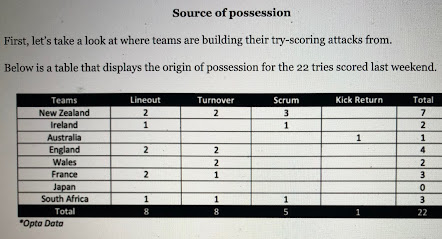How to use your lineouts to score with variety, looking at the British and Irish Lions.
The British and Irish Lions have played two games already against Japan and the Sigma Lions. Warren Gatland will be happy with how things are going now as they prepare for the rest of the tour.
There are a few articles out on tries scored and the source of possession it came from and most will tell you that most of those tries scored would have come from lineouts. Below is a image obtained from Opta Data which focused on the tries scored in the rugby world cup quarterfinals in 2019. The full article was written by Eoin Toolan who is a performance analyst and can be found here for deeper reading:
https://www.the42.ie/analysis-world-cup-quarter-final-tries-4864914-Oct2019/
So far we have seen a few tries from the British and Irish Lions where they are looking to score from first phase and from their lineouts, attacking the transition zone and vacuum and looking to put opposition under pressure. But first the intention is not just to set up, play phases and get into structure but score as soon as possible. We take a look at the following clips to get a better understanding.
First things first what is the transition zone? The transition zone is the link between the lineout and the rest of the defence line or if its from a scrum the link between the backs and the scrum. These zones if not covered and if defence doesn't connect well and quickly, can really cause problems for teams that are weak there.
1st Clip
In this clip against Japan we see a peel and Bundee Aki clearly attacking the transition zone and making metres. If defence does not connect and close that space quickly that can result in easy yards for attack. Attacking those transition zones and vacuums can be rewarding for teams if they do their analysis and pick up that defence are rather slow to close that space down. Japan managed to eventually stop Bundee Aki and a few phases later the British and Irish Lions scored.
2nd Clip
The British and Irish Lions set up a maul and earn a little bit of momentun. The Japanese manage to stop it but had to sacrifice using extra players to stop the rolling maul. This forces defence to also get sucked in. Connor Murray picks up Robbie Henshaw with a hard line which makes it almost impossible for defence to stop him. Also have a look at the defence focusing on the maul and Connor Murray, they end up by identifying Robbie Henshaw as a threat when it was already too late.
3rd Clip
In this clip we see a fake maul and Hamish Watson plays as a link. Owen Farrell comes in on the hardline and Watson plays Ali Price in behind Farrell's hardline. Ali Price commits two defenders onto him and then plays Josh Adams whose running an inside option. You can clearly see the stress that the British and Irish Lions have placed on the transition zone with defenders sitting on their heels and taking out the connection but having options running into the transition zones.
4th Clip
In this clip we note that if you don't set up quickly to defend, smart teams will take advantage. Have a look at the slow reaction to set from the defence as well as how poorly the connection was from the lineout to the rest of the defence line. In this one we have an overthrow straight to Owen Farrell who then plays Ali Price on a wrap around running into space getting to the tryline untouched.
So what do these tries teach us? The British and Irish Lions are going to punish you if you are not set and organised from first phase defence. They want to score from first phase and if they can't they will be patient in their structure to break you down. They use alot of variety from their attacking lineouts ie fake mauls, peels, overthrows and incorporation of backs and forwards from lineouts, which can make it tough to defend as you might not be aware of what is going to come next. Teams that still have to play them have to make sure that they set first, have clear roles on who is connecting from the forwards and backs to close the transition zone and be able to assess all available threats.
Katleho Lynch




Comments
Post a Comment